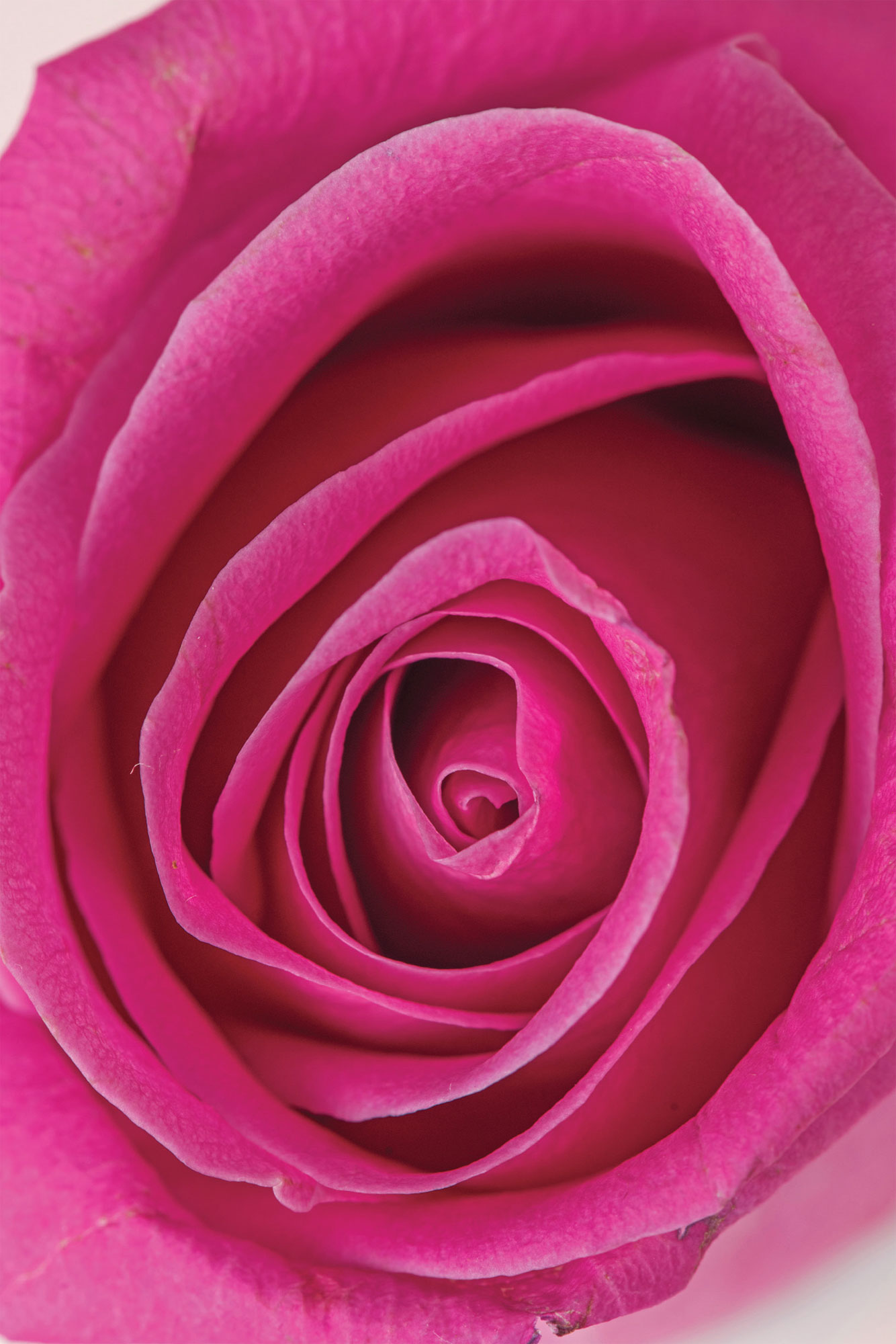CHAPTER 2

Herbs for Women

THROUGHOUT THE REST OF THIS BOOK, I will be referencing herbs by name. Although many of the herbs listed below are used throughout the body, this materia medica is curated to how these herbs are used for women’s health. I say this because it is important not to pigeonhole an herb into one function. The key is to remember that herbs have an affinity for certain areas of the body, but their actions can be applied in many ways. Earlier I mentioned the art of creating a medicinal herb blend verses simply picking herbs based on their action. Although using single herbs for specific reasons has merit, understanding tissue states and herbal energetics is important to creating a successful blend. If you are looking to learn more, refer to the book The Herbal Apothecary or other resources on creating medicinal blends. In the meantime, learn the herbs. I suggest getting an ounce (28 g) of one or two herbs to play with each week. Look at them in their fresh or dried form, smell them, and try them as tea or tincture. This will provide a much richer experience versus just reading about them. Be sure to note in your journal how they taste or make you feel. This information will provide you with keen insight into the herb.
This book divides life into three phrases: Dawning, menarche to young adulthood; Living, young adulthood through reproductive years; and Fulfillment, the post- reproductive years. But before we discuss herbs by life phase, this section lists them individually. Each entry includes the herb’s name, the phase of life in which it is most often used, its primary use, its herbal action, and foundational information about it. These brief descriptions only provide the tip of the iceberg when it comes to knowing each herb and its potential. Review these first to familiarize yourself and then go to the groupings list. It makes for quick referencing when you are looking things up. I’ve also included herb lists throughout the book for easy shopping, recipe fulfillment, and/or pantry stocking.
AGRIMONY, Agrimonia eupatoria
A. PHASE OF LIFE: Dawning
B. PRIMARY USE: A friend to those who wear the mask that all is well but are suffering inside
C. HERBAL ACTION: Emmenagogue, hepatic, astringent, cholagogue
My first encounter with agrimony, while I was walking through my mentor’s garden, was when it literally jumped out and grabbed me. Its little yellow flowers and the stickers that attached themselves to me instantly bedazzled me. I felt calmer just standing next to it. Agrimony is traditionally used to calm digestion, aid in menstrual regulation when menses are present but not consistent, and support the liver-gallbladder connection. But it was the plant’s emotional offerings that affected me the most. It’s recommended for those who have had a shock or a moment when their experience caused them to hold their breath, and they’ve been holding it ever since; agrimony reminds us to breathe again. For those who hold everything in their stomach, agrimony aids in the release of tension in the entire abdominal area, including the uterus.
ALFALFA LEAF, Medicago sativa
A. PHASE OF LIFE: Living
B. PRIMARY USE: Support for and an alkalizing effect on the structures of the body
C. HERBAL ACTION: Tonic, diuretic
Whenever minerals are needed, I use alfalfa. If I notice prolapse, loose ligaments, or generalized fatigue, I often include alfalfa. Some herbalists believe—and I can’t argue—that alfalfa’s mineral content fluctuates widely. As with anything, knowing your source is important. But I also can’t deny that my goats crave the extra minerals once they are with babe. Currently, I have nine goats, four of whom are pregnant. The smallest of all of them, Electra, grabs three alfalfa flakes each morning and hoards them for herself. If the other goats try to share, she jumps on their back until they finally go away!
Alfalfa also has an alkalizing effect on the body, combating the overly acidic nature of our digestive tracks and other systems that present as irritated.
ANGELICA ROOT, Angelica archangelica
A. PHASE OF LIFE: Dawning, Living
B. PRIMARY USE: Support for the female reproductive system through the movement of blood
C. HERBAL ACTION: Emmenagogue, nervine, stimulant, tonic, carminative, bitter
Once coined “the female ginseng,” angelica is a superior women’s reproductive tonic. It’s good for pelvic congestion and suppression of the menstrual cycle. It gently warms the pelvis and moves circulation throughout. Traditionally used for menstrual headaches and premenstrual syndrome (PMS) digestive upset, it’s also good to include in menstrual balancing recipes when the liver appears to be a bit sluggish.
ANISE SEED, Pimpinella anisum
A. PHASE OF LIFE: Fulfillment
B. PRIMARY USE: Easing digestion, inhibiting cramping
C. HERBAL ACTION: Antispasmodic, aromatic, carminative, digestive, tonic
Anise is best known for its abilities to soothe digestion and gas, but its pain relief goes beyond the digestive track. You can use anise seed oil for menstrual cramping and/or tender breasts. Babies who are suffering from colic will benefit from teaspoon drops of anise seed tea. If taken in larger, concentrated quantities, it may bring on menstruation. Anise water is thought to increase milk production in nursing mothers.
ASHWAGANDHA, Withania somnifera
A. PHASE OF LIFE: Fulfillment
B. PRIMARY USE: A natural brain booster, energizer, and overall tonic for the body
C. HERBAL ACTION: Adaptogen, tonic, aphrodisiac, hepatic, sedative
I first began using ashwagnadha as a tonic for a severely immune debilitated patient. Its ability to strengthen the overall immune system as well as bodily systems made it almost seem like a superfood. It also worked on the central nervous system, making the patient less stressed and better able to handle the hurdles her body was presenting. I’ve recommended it for the two major types of anemia, Pernicious anemia and iron deficiency anemia—not to fill the gap of deficiency but to provide a stabilizing tonic to decrease overall fatigue. Research shows that the amino acids present in ashwagnadha help improve brain function, calm the overly excitable states, and even work to balance natural sleep cycles.
ASTRAGALUS, Astragalus membranaceus
A. PHASE OF LIFE: Living, Fulfillment
B. PRIMARY USE: Support for the overall vitality of the immune system
C. HERBAL ACTION: Adaptogen, immunostimulant, antiviral, nervine
Astragalus is another herb that can be taken as medicine or added to your food to turn your culinary creations into medicine. It can often be purchased in whole root form at co-op grocery stores, and it can turn soups into power-packed immune system boosters. Although astragalus will do its best to keep the colds and flus away, its job isn’t to help fight them. Instead, it works to tone the overall immune functions of the body, increasing your body’s ability to keep invaders from settling in. It also influences the central nervous system, which means it can encourage the reduction of stress. When stress goes down, immune systems strength goes up. As an adaptogen, astragalus finds imbalance in the body and corrects it.
BLACK COHOSH, Cimicifuga racemose, Syn. Actaea racemose
A. PHASE OF LIFE: Living, Fulfillment
B. PRIMARY USE: Stimulating labor and regulating contractions
C. HERBAL ACTION: Emmenagogue, antispasmodic, nervine, alterative, expectorant, diuretic
Although we typically think of black cohosh as a women’s herb, it should also be considered a powerful normalizer for both men and women to balance hormones and to reduce pain and discomfort. It helps reduce cramping or ovarian pain, quiets the womb (unless it is time for birth), reduces arthritic and nerve pain, and acts as an excellent central nervous system healer. I first used it as an anxiety treatment in 1999 after reading about Michael Tierra’s use of it with various nervous conditions with concomitant muscle pain. Michael Tierra is an herbalist who specializes in blending Eastern and Western herbs and has a great herb book called The Way of the Herbs. (Side note: His wife, Lesley Tierra, wrote my favorite beginner Chinese herb book called The Herbs of Life.) But the nerve tonic Michael wrote about worked well, and I continued to use it in broad ways to reduce muscle tension and tremors caused by stress, menopausal symptoms, anxiety, insomnia, and reproductive congestion.
BLESSED THISTLE, Cnicus benedictus
A. PHASE OF LIFE: Living
B. PRIMARY USE: Nutritive, hormone balancing, liver support, pregnancy
C. HERBAL ACTION: Bitter, emmenagogue, galactagogue, stimulant, tonic
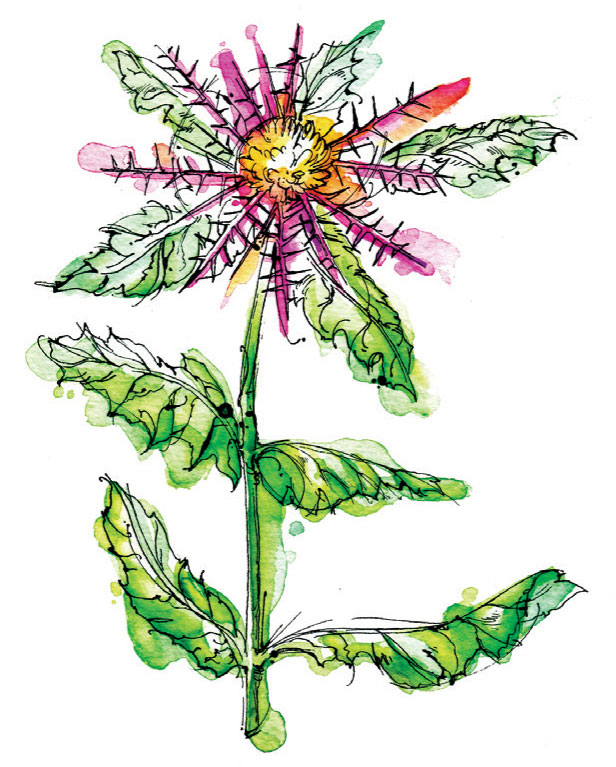
Blessed Thistle
When I think of blessed thistle, I think of hormonal balancing through liver detoxification. But it’s actually a multitasker, supporting the endocrine system while aiding the master detoxifying actions of the liver. This herb is a great choice when you suspect that your hormone imbalance is not originating from the reproductive organs themselves. Its ability to gently cleanse the blood makes it helpful for troublesome skin conditions such as acne. Traditionally known as a “corrective” for reproductive systems, it will lower what is too high and raise what is too low. It helps women who have irregular menstrual cycles or who are looking to increase breast milk supply. For those experiencing emotional fluctuations, blessed thistle is known to clear and calm the mind and heart. It’s a key herb for the women’s home herbal pantry.
BLUEBERRY, Vaccinium spp.
A. PHASE OF LIFE: Fulfillment
B. PRIMARY USE: A great source of antioxidants that can be used as a food or dried for winter tea recipes
C. HERBAL ACTION: Antioxidant
Although not always readily available at herb shops, blueberries have their place as a medicinal berry. High in antioxidants, they work to scavenge the body for free radicals, improving skin and cellular integrity. The berries also seem to have an affinity for the eyes and heart, making them a worthwhile addition to microcirculatory-focused herbal blends.
BLUE COHOSH Caulophyllum thalictroides
A. PHASE OF LIFE: Living
B. PRIMARY USE: Traditionally used to initiate labor and regulate contractions throughout
C. HERBAL ACTION: Emmenagogue, oxytocic, diaphoretic, diuretic
Often combined with black cohosh and drunk as a tea during the last week of pregnancy, blue cohosh is known to prepare the uterus and body for labor. When labor has gone on long enough, blue cohosh can at times provide relief and completion by supporting the fatigued uterus in regular and strong contractions. Considered a uterine stimulator, blue cohosh is also used to bring on menstruation. Other uses for blue cohosh have included amenorrhea, uterine fibroids, and PMS.
BUCHU Agathosma betulina (previously Barosma betulina)
A. PHASE OF LIFE: Dawning
B. PRIMARY USE: A superior bladder antiseptic helpful with cystitis, infection, and leucorrhea
C. HERBAL ACTION: Antibacterial, diuretic
Buchu is a good choice as dual action for bladder and vaginal inflammation. It has antibacterial fighting power combined with a soothing action to reduce pain and discomfort. When there is no infection but a constant excessive vaginal discharge, buchu is recommended. I recommend this herb when woman present with “cold kidneys.” This presents as lower back pain with vaginal and/or bladder complaints but no infection. In Chinese medicine, we would consider it a kidney deficiency, and one of the ways to treat that is to warm up the kidneys. Using buchu, along with wrapping your torso under your clothes, works to raise the energy and temperature of the kidneys.
BUPLEURUM Bupleurum falcatum
A. PHASE OF LIFE: Fulfillment
B. PRIMARY USE: Works directly with the liver to clear estrogen
C. HERBAL ACTION: Hepatic, antiviral, antispasmodic, anti-inflammatory
Working on multiple levels, the Chinese medicine herb bupleurum is a superior women’s herb. It helps correct estrogen dominance, which often leads to a reduction in tension. It can relieve pain and correct simple digestive complaints. One of the main medicinal components of bupleurum mimics progesterone. Taken throughout the month, it is known to reduce PMS, particularly anxiety, fatigue, and breast tenderness.
BURDOCK ROOT Arctium lappa
A. PHASE OF LIFE: Dawning, Living
B. PRIMARY USE: A superior liver-supporting herb; helpful to “ground” those who are often distracted
C. HERBAL ACTION: Tonic, cholagogue, diuretic
Burdock is a helpful herb for supporting the liver’s natural detoxification pathways. It can be eaten as well as taken in herbal medicine forms. My family loves our burdock in stir-fry! As with any liver-supporting herbs, you’ll get hormonal support. It’s traditionally used during pregnancy as a nutritive and helpful herb to stay vital and well throughout.
BURDOCK SEED Arctium lappa
A. PHASE OF LIFE: Dawning
B. PRIMARY USE: Soothes and tones the bladder
C. HERBAL ACTION: Relaxant, demulcent, tonic
Note that we’re talking about burdock seed here; I like to differentiate it from the root, as it has its own action on the bladder and skin. I have found burdock seed to be helpful when a woman is experiencing bladder urgency, particularly when exacerbated by stress. It seems to give tone to areas that are triggered by overly excited nerves. It’s also useful for cystic acne to help to clear the body of the buildup leading to breakouts. It’s a good one to include in recipes to gain integrity and smoothness to the skin.
CALENDULA FLOWER Calendula officinalis
A. PHASE OF LIFE: Living
B. PRIMARY USE: Skin healing and health, lymph congestion
C. HERBAL ACTION: Antibacterial, antifungal, emmenagogue, astringent, anti-inflammatory
Calendula is said to keep the skin healthy and strong. Typically used in salves for burns, cuts, scrapes, and stings because of its antibacterial properties, it also does an incredible job of pulling tissues back together to expedite healing. Only use calendula when you are ready for a wound to close, because it will work quickly. Sometimes a wound needs to be left open for a while so as to not trap in infection or to heal from the inside out—what is known as healing from the first intention.
Calendula is also a safe and efficient lymphatic system agent. I recommend it if you are fighting off a cold or flu, or if you have chronic lymphatic congestion. It’s also a gentle normalizer for the female reproductive system; it can help bring on delayed menstruation, reduce cramping, and reducing bleeding and pelvic congestion.
CALIFORNIA POPPY Eschscholzia californica
A. PHASE OF LIFE: Fulfillment
B. PRIMARY USE: An uplifting, pain-reducing, sedative effect
C. HERBAL ACTION: Antispasmodic, relaxant, nervine, sedative
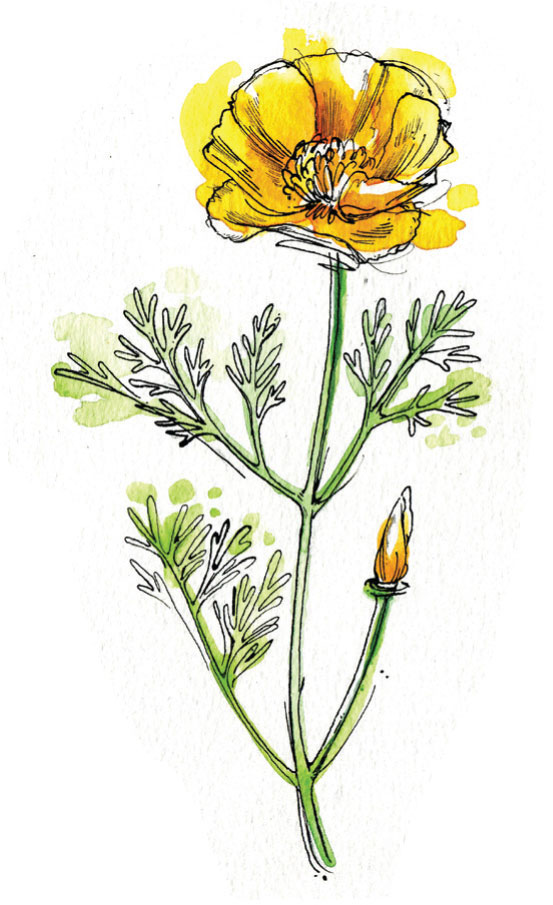
California Poppy
This nervine works on the physical level, directly affecting the mental state into relaxation. When your muscles can release tension, chemicals are released, often allowing the mind to shift into a more peaceful state. California poppy is helpful to take before bed or in extreme states of adrenal activation. It’s a good choice when pain is inhibiting the ability to sleep. Note that it is contraindicated with monoamine oxidase (MAO) inhibitors.
CATNIP LEAF Nepeta cataria
A. PHASE OF LIFE: Dawning
B. PRIMARY USE: Has a strong healing effect on the stomach, reducing discomfort, tension, and nourishing deficiency
C. HERBAL ACTION: Stomachic, antispasmodic, diaphoretic, carminative
I believe that the stomach is where we hold a lot of what we feel. You can relate if you “feel” your stomach tighten with fear or stress. This is my go-to for stomachaches in teenagers, who tend to feel everything around them. It’s a wonderful addition to any tea to soothe and strengthen the stomach and digestive track. It’s also a good choice for mild fevers to encourage gentle sweating to reduce the fever.
CAYENNE Capsicum minimum
A. PHASE OF LIFE: Living, Fulfillment
B. PRIMARY USE: Stimulates circulation
C. HERBAL ACTION: Stimulant, carminative, anticatarrhal, antimicrobial, rubefacient
Cayenne is an excellent stimulator of the body. I use it to move stagnation when pain is present, to warm up the extremities, and any time the brain needs a bit of a boost in memory or clarity in function. When added to creams or lotions in the right amount, it produces a slight warmth to get the blood moving. It’s been used to relieve hoarseness, sore throat, toothache, tonsillitis, fibromyalgia, and arthritis and to increase metabolism. There’s no need to be wary of cayenne pepper; as with anything, when used with careful consideration, positive results are possible.
CELERY SEED Apium graveolens
A. PHASE OF LIFE: Dawning
B. PRIMARY USE: Anxiety relief
C. HERBAL ACTION: Carminative, sedative
I sort of stumbled onto the effects of this herb, and I’ve loved it ever since. I once had a patient who was one of the most loving and caring mothers around, but she fretted about her children endlessly. Were they sleeping okay, eating right, engaging with friends enough? You name it, she worried about it. When I have patients with anxiety and worry, I never downplay the realness of what they are experiencing and know it manifests in physical ways such as insomnia, digestive complaints, headaches, and so on. The trouble was that this patient was also not extremely open to trying new treatment ideas. We talked for quite a while, and then she took out some celery sticks for her kids to snack on. In that moment, I remembered that celery seed had been used for anxiety and stress. I asked her if she was open to trying a celery seed tincture and she agreed. Within three days she e-mailed me to say how much her concern seemed to have quieted down. She felt able to breathe through the flashes of fear she had for her family and was able to identify a more rational view. When celery seed is blended with nervines, it tends to soothe panic and extremely stressful moments in women, especially those who are overly concerned about others and the world and are easily triggered. Combining its sedative effects with carminative actions, you also get the relief of tension held in the abdomen. Considered another micro-traversing herb, it can travel into small spaces to move stagnation and release trapped energies. Note that it is contraindicated in pregnancy.
CHAMOMILE FLOWER Matricaria recutita
A. PHASE OF LIFE: Dawning
B. PRIMARY USE: A quiet and gentle nervine that works to balance the central nervous system and hormones
C. HERBAL ACTION: Nervine, carminative, bitter, sedative, anti-inflammatory, antispasmodic, emmenagogue
Chamomile tea is many people’s first experience with herbal tea. The delicate flowers have an incredible aroma and, if steeped correctly, a sweet and subtle taste. I love growing chamomile in my garden, but I am lucky if I get six cups of tea from my harvest. Collecting the tiny flowers is laborious but worth it for the fresh tea, a very special treat.
Many years ago, I learned that chamomile can have a hormone balancing effect on the reproductive system. Most often this is used in combination with peppermint, taking one cup of peppermint during the first half of the menstrual cycle and chamomile during the second half. I was experiencing irregular cycles at the time and decided to give this a try. Starting simple is the best way to begin with herbs. Although our society often claims, “Go big or go home,” herbs typically work wonders in small ways. Ever since I had success with this simple treatment, I’ve recommended it, with similar positive results. Chamomile is a great addition to any tea for its flavor and the benefits of soothing both the nervous and digestive systems. But don’t steep too long, as bitterness will overtake the tea.
CHICKWEED Stellaria media
A. PHASE OF LIFE: Dawning, Living, Fulfillment
B. PRIMARY USE: A cooling herb for both internal and external heat conditions
C. HERBAL ACTION: Carminative, demulcent, expectorant, nutritive
I recommend chickweed for topical heat rashes, boils, and hot wounds to reduce the inflammation, which will often allow other herbs to get in and do their work. Internally, chickweed is cooling to the liver and can help with hot flashes and to balance the hormones. If you’re experiencing mastitis, applying a fresh chickweed poultice will often produce relief. Almost any heat condition in the body can benefit from chickweed; it’s a must-have for any medicine cabinet. Luckily, it is another one of those “weeds” that proliferates in almost every state.
CHICORY ROOT Cichorium intybus
A. PHASE OF LIFE: Fulfillment
B. PRIMARY USE: A natural coffee substitute with the additional benefit of nourishing the liver
C. HERBAL ACTION: Appetizer, cholagogue, digestive, diuretic, tonic
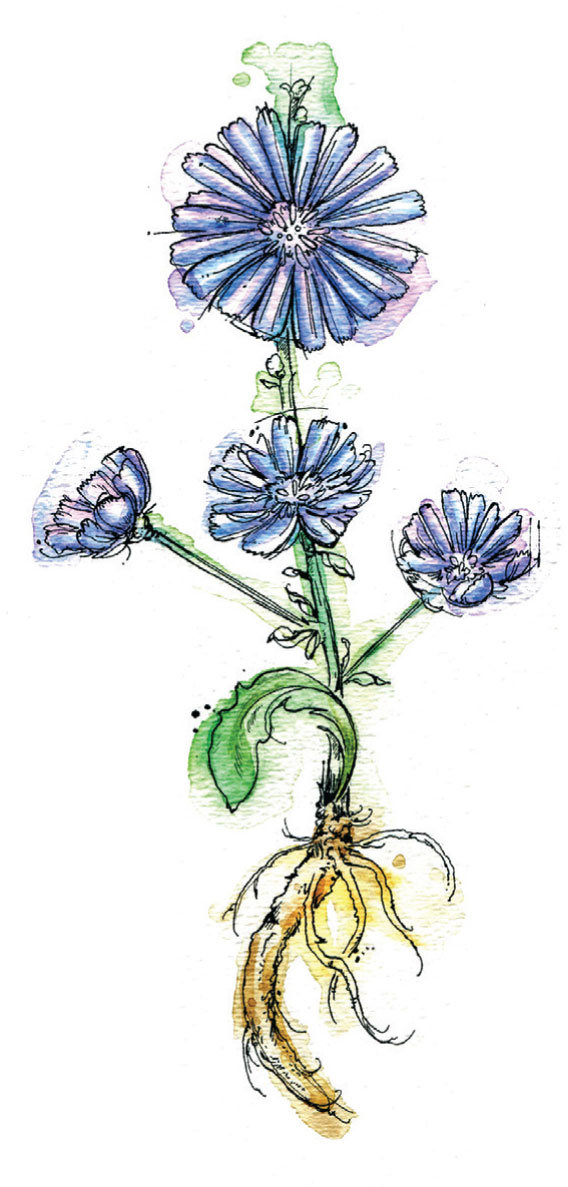
Chicory Root
The beautiful blooming of the chicory flower is bittersweet for me. Literally and figuratively! It marks the end of summer, but the dazzling blue is mesmerizing. Although it may seem like yet another herb that balances hormones, and it is, it has a unique flavor all its own. I like to nourish my liver while drinking something that tastes very much like coffee from the deeper flavor perspective. Chicory is moistening by nature, so if there is any heat and/or stagnation occurring in the reproductive glands, it may be a good solution to try.
CINNAMON BARK Cinnamomum zeylanicum
A. PHASE OF LIFE: Living, Fulfillment
B. PRIMARY USE: A warming and astringing herb that works to slow or stop bleeding
C. HERBAL ACTION: Analgesic, antibacterial, astringent, antiviral, antioxidant
Research has been done on cinnamon’s benefits to both uterine fibroids and polycystic ovary syndrome (PCOS), perhaps due to its warming, stimulating action that moves stagnated energy and blood from the reproductive system. The astringency pulls tissues together and constricts blood vessels to slow excessive bleeding. It is also helpful with leucorrhea.
CLEAVERS Galium aparine
A. PHASE OF LIFE: Living
B. PRIMARY USE: A gentle mover of lymphatic fluid to support the immune and kidney systems
C. HERBAL ACTION: Astringent, diuretic, tonic, vulnerary
Cleavers is another one of my favorites from personal use and experience. It seems the lymphatic system is being forced to work harder than ever in our modern world due to environmental exposures. And this herb is always offering itself to help. Growing almost everywhere, it jumps out and clings to us to remind us of its presence. Because it’s gentle enough to be used with some regularity, I use it often in my spring cleansing recipes. I’ve used it with success on lymph congestion throughout the body, including the inguinal glands. It’s another herb to consider if you’re suffering from acne, to support the waste management of the body.
CRAMPBARK Viburnum opulus
A. PHASE OF LIFE: Dawning
B. PRIMARY USE: A go-to herb for menstrual cramp relief that focuses on relaxing smooth muscle
C. HERBAL ACTION: Antispasmodic, astringent, tonic, nervine
Crampbark’s effects can often provide relief from acute cramping when one’s menstrual cycle kicks in, but I like to recommend taking it before the cycle. Using crampbark as a tonic creates a tonifying effect that can be relaxing to the uterus. This prepares the uterus for menstruation without having to contract so extremely to purge the layers of the endometrium. Herbalist James Duke has cited the two constituents that work to relax the uterine muscles, aesculetin and scopoletin, which have antispasmodic and anodyne properties. Historically, crampbark and its closely related cousin, black haw, have been used to prevent miscarriage by ceasing cramping and helping the uterus relax. They’re traditionally combined with astringent and other pain-reducing herbs.
CRANESBILL Geranium maculatum
A. PHASE OF LIFE: Fulfillment
B. PRIMARY USE: A powerful astringent to stop bleeding or leucorrhea and balance vaginal pH
C. HERBAL ACTION: Astringent, styptic
When vaginal discharge is excessive, cranesbill can be used internally or externally as a douche. It can also be used as a tincture or tea to inhibit uterine bleeding.
COMFREY LEAF Symphytum officinale
A. PHASE OF LIFE: Living
B. PRIMARY USE: Skin healing and health, lymph congestion
C. HERBAL ACTION: Antioxidant, astringent, demulcent, emollient
Comfrey is one of those plants surrounded by controversy. Considered a troublesome weed, this beautiful plant is often ripped from gardens. If people only knew the healing potential it contains! The Latin name comes from the Greek word symphyo, meaning “to make grow together,” referring to its traditional use of healing fractures. But it also works wonders on the tissues of the body and skin. It has a long history of relieving inflammatory and arthritic pain, as well as just about any skin irritation.
The warnings regarding comfrey began in the 1970s. Experimental data showed that lab rats fed comfrey three to four times their body weight over a long period of time developed liver damage. It would take a human drinking three to four cups of comfrey tea for 140 years to achieve the same effect. Alkaloids known as pyrrolizidines, which are concentrated in the root, less so in the leaves, are the culprits. Extensive research on comfrey and its toxicity potential shows that it’s of low toxicity concern. The absorption of pyrrolizidine alkaloids is limited when applied topically, and the pyrrolizidine alkaloids in comfrey are considered to have a low hepatic toxicity type compared to other types. Check out herbalist Dorena Rode’s work if you are looking for more scientific research and information. Comfrey was used and recommended often until the mid-1980s, when unsubstantiated research surfaced. The Henry Doubleday Research Center in England studies a group of people who have been eating comfrey as a cooked green for three generations now, including through pregnancies and lactations; no harm has been reported.
CORN SILK Zea mays
A. PHASE OF LIFE: Dawning
B. PRIMARY USE: Soothing irritation and inflammation throughout the body
C. HERBAL ACTION: Demulcent, diuretic
Corn silk is useful in the treatment of painful bladder irritation and for gentle treatment of generalized edema. A demulcent by nature, it helps relieve inflammation in most mucus membranes of the body. This is particularly true in the colon when laxity and irritation have become chronic. Corn silk is known to be helpful in returning tone to this system, as well as to the uterus.
DANDELION Taraxacum officinale
A. PHASE OF LIFE: Dawning, Living, Fulfillment
B. PRIMARY USE: Hormonal balancing
C. HERBAL ACTION: Tonic, cholagogue, bitter, stomachic, diuretic
Here’s another “weed” that is all around us! You can use all parts of the dandelion plant—roots, leaves, and flowers. The roots act on the liver to gently balance hormones, binding excess hormones and toxins. The leaves work on balancing water states in the body, and the flowers are just for edible fun. Skin also tends to benefit from the regular use of dandelion root and leaf, because it doesn’t have to be supporting the liver in detoxification. According to Rosemary Gladstar, the root is invaluable for those going through menopause; it provides the essential nutrients needed to help the hormones find their new level of homeostasis.
DEVIL’S CLAW Harpagophytum procumbens
A. PHASE OF LIFE: Fulfillment
B. PRIMARY USE: Anti-inflammatory actions
C. HERBAL ACTION: Anti-inflammatory, bitter, analgesic, anodyne, hepatic
Prized for its herbal constituents, which fight pain and inflammation, initial studies show devil’s claw’s ability to help with back pain, headaches, and arthritis. It’s also traditionally used for gout and digestive complaints, particularly indigestion symptoms.
DONG QUAI Angelica sinensis
A. PHASE OF LIFE: Living, Fulfillment
B. PRIMARY USE: A tonic that works through the liver to balance hormones; also a cardiac tonic
C. HERBAL ACTION: Adaptogen, tonic, emmenagogue, hepatic
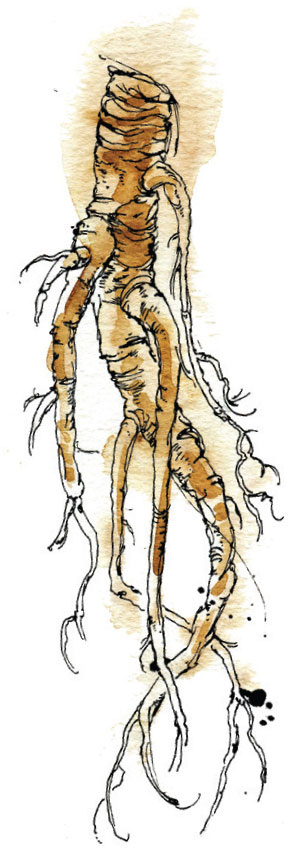
Dong Quai
My first experiences with dong quai taught me how nourishing the liver builds healthy blood for the reproductive system. It promotes regular menstruation and tonifies the reproductive system. It has a sweet and spicy taste and can be eaten daily in small amounts for medicinal purposes. When used for the heart, it supports overall circulation and regulates rate and rhythm. Dong quai is also recommended when perimenopause begins to help support the hormones into their new levels. Do not take during menstruation.
ELEUTHERO ROOT Eleutherococcus senticosus
A. PHASE OF LIFE: Dawning, Living
B. PRIMARY USE: An adaptogen and antiviral herb extraordinaire
C. HERBAL ACTION: Adaptogen, antiviral, immunostimulant
Traditionally used mainly as an adaptogen to reduce stress and correct cortisol imbalance, eleuthero also has strong antiviral and immune system fighting powers. I’ve always said that when stress goes down, immune function improves. Herpes outbreaks, for example, tend to return when stress is high, almost activating the virus to wake up. Taking eleuthero in advance of stressful times may cut off the reactivation cycle. Eleuthero is also called Siberian ginseng. It does a good job giving strength to the debilitated and weak and those under chronic stress. It has a neutralizing quality, unlike true ginseng, and it does not provoke an overstimulated state.
FENNEL SEED Foeniculum vulgare
A. PHASE OF LIFE: Living
B. PRIMARY USE: Pregnancy, digestion
C. HERBAL ACTION: Galactagogue, carminative
This tiny seed is power packed with flavor and healing effects for the body. Used for centuries to heal digestive complaints and regulate the reproduction cycle, it’s frequently utilized by most traditional herbalists. Safe enough for children, it is my go-to for my daughter, Cordelia, whenever she is experiencing stomachaches (whether physical or emotional). Fennel works well to release gripping of the abdomen, and new breastfeeding mothers can drink it to help their little ones with colic. It can also be used for morning sickness to calm the queasy stomach and help clear the mind. Modern research shows that it contains some slight estrogenic compounds, which may be why it aids in increasing breastmilk and regulating menstrual cycles. Because of this, avoidance or small doses are necessary for those with estrogen-driven pathologies.
FENUGREEK SEED Trigonella foenum-graecum
A. PHASE OF LIFE: Living
B. PRIMARY USE: Increasing breast milk production, relieving digestive upset and gas
C. HERBAL ACTION: Galactagogue, carminative
If you’ve ever cooked with fenugreek, you are quite familiar with its aroma, produced by the plant’s volatile oil. Plants with volatile oils are often soothing to the digestive process, relieving both gas and bloating. There is a reason fenugreek is often included in the rich foods we all enjoy so much!
Fenugreek is one of the most popular herbs for trying to increase breast milk production. Although we still don’t have definitive research on how or why it increases breast milk, there is research proving that it does. Research also shows an increase in baby weight and head circumference with the mother’s use of fenugreek. One important consideration is dosage; there seems to be agreement that taking less than 3,500 mg, or 3.5 grams, per day will produce no effect. This is an example of needing to take an herb in an adequate dose, repeatedly throughout the day.
Other reported uses include to alleviate heartburn and bad breath, menopause support, and ulcer healing.
GENTIAN Gentiana lutea
A. PHASE OF LIFE: Fulfillment
B. PRIMARY USE: A bitters extraordinaire that works to positively promote digestion
C. HERBAL ACTION: Stomachic, carminative, bitter, hepatic
Gentian root is a key ingredient in bitters because it can increase gastric secretions. It promotes overall health of the digestive system and supports the liver by aiding in the breakdown of fat and protein. Bitters are recommended for anyone who feels tired after eating, as they will decrease the digestion time and increase accessible energy from food.
GINGER ROOT Zingiber officinale
A. PHASE OF LIFE: Living
B. PRIMARY USE: A warming reproductive tonic, great for relieving congestion
C. HERBAL ACTION: Antispasmodic, carminative, stimulant
I always reach for ginger when I suspect lack of good circulation in the pelvic region. When the vessels surrounding the uterus and ovaries are constricted, you have a lack of warm blood flowing in and around the reproductive system. Using ginger gently warms that up, increasing flow and reducing pelvic congestion. This same effect can be applied to the digestive system, particularly when nausea is present.
GINKGO Ginkgo biloba
A. PHASE OF LIFE: Dawning, Fulfillment
B. PRIMARY USE: Protection for the nerves and cells of the body
C. HERBAL ACTION: Antioxidant
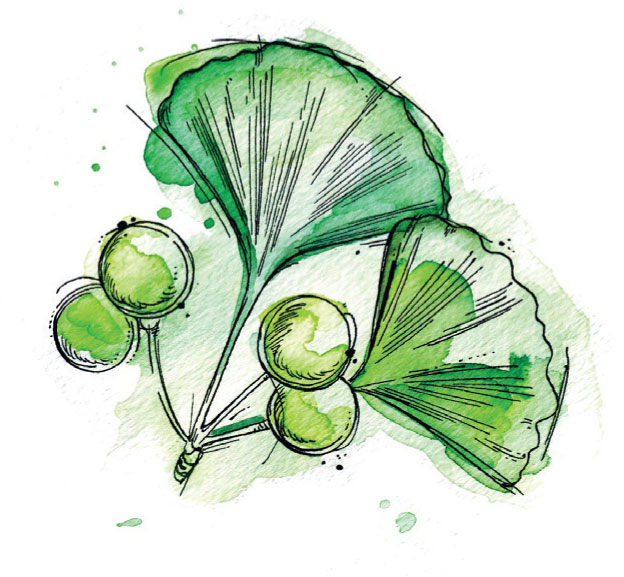
Ginkgo
Ginkgo is one of the most widely researched herbs, and that research has shown some positive findings. It is well known to provide mental acuity and increased awareness, but new findings are also showing its ability to increase osteoblastogenesis, which is great news for those looking for healthy bone support as we age. As ovulation ceases, it impacts calcium uptake and bone health. Finding ways to keep strong into menopause is vitally important. Although eating the right foods to reach our calcium needs is ideal, it isn’t always possible. Another study showed that regular intake of ginkgo helped reduce breast tenderness before menstrual cycles.
GOAT’S-RUE Galega officinalis
A. PHASE OF LIFE: Living
B. PRIMARY USE: Increasing breast milk production
C. HERBAL ACTION: Galactagogue
Goat’s-rue is an amazingly supportive herb for all new mothers. I first learned of its use from Juliette de Bairacli Levy, an incredible herbalist from Manchester, England. As an herbalist and veterinarian, Juliette has used her keen sense and knowledge to teach us much about using the same plants that animals use naturally. New goat mothers thrive on goat’s-rue, and it has now been proven to increase the natural production of human breast milk. It seems to be particularly helpful for women with low breast glandular tissue, perhaps working specifically on the mammary glands.
Goat’s-rue has traditionally been used to treat diabetes; it contains the alkaloid galegine, which has been found to reduce blood sugar and insulin resistance. Some research has focused on goat’s-rue’s ability to reduce weight.
GOLDENROD LEAF Solidago virgaurea, Solidago canadensis
A. PHASE OF LIFE: Dawning
B. PRIMARY USE: Fighting allergic reactions and improving kidney function
C. HERBAL ACTION: Astringent, carminative, diaphoretic, diuretic
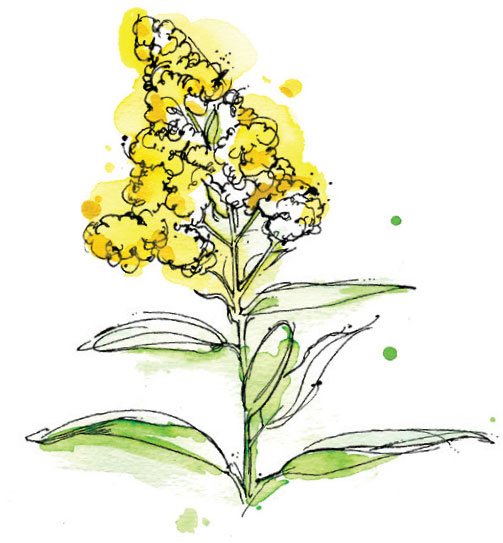
Goldenrod
Goldenrod is often used in bladder tonics or recipes for cystitis. This isn’t due to its specific action on the bacterial infection so much as its ability to kick the kidneys into action, increasing filtration and function in an attempt to drive the infection from the body. It is also known to help relieve congestion of the upper respiratory system and combat conjunctivitis.
GOLDENSEAL Hydrastis canadensis
A. PHASE OF LIFE: Living, Fulfillment
B. PRIMARY USE: PCOS, diabetes, digestive healing, infection
C. HERBAL ACTION: Antiseptic, astringent, tonic, diuretic
Due to overharvesting, wild goldenseal is nearly nonexistent, and cultivation is a demanding undertaking. Combine these two problems, and you have a very expensive herb. Unfortunately, sometimes goldenseal cannot be replaced with another herb. One such case is extreme digestive damage, when the mucous membranes have lost their integrity and decreased in function. Taking tablespoon doses of goldenseal infusion multiple times per day is incredible treatment. Goldenseal is known to reduce fasting plasma glucose levels, which is great for blood sugar regulation, but also for the benefit of your ovaries, particularly if PCOS is a problem.
GOTU KOLA Centella asiatica
A. PHASE OF LIFE: Living, Fulfillment
B. PRIMARY USE: Well known as a “brain” herb; also supports microcirculation
C. HERBAL ACTION: Adaptogen, anti-inflammatory, antimicrobial, vulnerary, vasodilator, astringent, nervine
Gotu kola is a good example of an herb that has been pigeonholed into one action. When we look deeper into its function, we can see that it has incredible abilities to move stagnation and stimulate healing. It’s great for the heart, skin, collagen, and joints. Research shows it may be helpful with pruritic urticarial papules and plaques of pregnancy (PUPPP), endometriosis, and stressful depression.
HAWTHORN BERRY, LEAF, AND FLOWERS Crataegus oxyacantha, Crataegus monogyna
A. PHASE OF LIFE: Fulfillment
B. PRIMARY USE: Insomnia, circulation, calming the heart
C. HERBAL ACTION: Cardiotonic, astringent, diuretic, hypotensive
One of my favorite herbal combinations for women is hawthorn berry and motherwort. This simple formula connects the heart to the kidneys, offering a rooted foundation upon which to gracefully move through your days. The hawthorn calms and supports the heart physically and emotionally, and the motherwort works to tone the heart and kidneys. Together, a peaceful exchange of energy, like a circuit, is created. I often visualize a kundalini meditation that works to move energy from the root chakra to the head and back to the root. In this mediation you are creating that circuit of energy up, out, and back down again. This is the same cycle I see hawthorn berry and motherwort creating. Meditation in a bottle!
HOP FLOWERS Humulus lupulus
A. PHASE OF LIFE: Living
B. PRIMARY USE: Sleep, stress, breastfeeding, pain relief
C. HERBAL ACTION: Bitter, sedative, galactagogue, nervine, anodyne
My mentor, Linda Quintana, and a friend spent a hardworking morning harvesting hops, carrying and filling multiple bags. Then they filled up the car and began to drive home. About fifteen minutes into the drive, Linda looked at her friend, who looked as tired as she felt. All the hops and their pollen had turned the car into a giant sedative capsule, forcing them to pull over and take a long nap in the sunshine. This is how hops seem to work. First you feel good, then hazy, then ready for bed. It’s one of my absolute go-to herbs for those struggling with sleep. I also recommend a tincture by the bedside for those who tend to wake up in the middle of the night and have their brains kick on, preventing them from falling back asleep. I also include it in my breastfeeding formulas, as it calms any stress the new mother may be experiencing. It is also a wonderful bitter to support and stimulate the appetite and digestion, as well as a great addition to pain relief formulas.
KAVA Piper methysticum
A. PHASE OF LIFE: Living, Fulfillment
B. PRIMARY USE: Acute stress reduction
C. HERBAL ACTION: Sedative, analgesic, diaphoretic, stimulant
Kava has been used for relaxation and sedation for centuries in the tropics, originating in Polynesia. I personally recommend its consumption at home when you have no plans for the evening. Some people are strongly affected by its sedation effects. There have been approximately sixty reports worldwide of kava having toxic effects on the liver, but most of these cases were in combination with either a preexisting liver condition or in those on hepatic medications.
The key to good kava, besides the kava itself, is the preparation. Never use hot water, as higher temperatures destroy kava’s active components, kavalactones. Use water or milk at room or lukewarm temperature. A fat-containing liquid such as cow’s or coconut milk is best for extraction. Let the kava steep for a few minutes and then strain and enjoy. The longer you allow it to steep, the stronger the effect will be. Some folks recommend putting the kava and milk in a blender and blending for one minute before straining and drinking. Kava has shown promise for anxiety, insomnia, PMS, and menstrual headache relief.
KELP Ascophyllum nodosum
A. PHASE OF LIFE: Living, Fulfillment
B. PRIMARY USE: Nutritive and helpful when working with hypothyroidism, fibrotic breast tissue, PMS
C. HERBAL ACTION: Tonic, diuretic
This is another seafood whose nutrients support a multitude of bodily functions. I recommend it for hormonal balancing and fibrotic breast complaints. Kelp doesn’t influence the hormones directly, but its nutrients aid in building and processing them. I once recommended a daily dose of dried kelp and almonds to a patient who was having difficulty managing PMS symptoms. Whether the kelp helped or her body worked things out on its own, after two months she reported little to no PMS.
LADY’S MANTLE Alchemilla vulgaris
A. PHASE OF LIFE: Living, Fulfillment
B. PRIMARY USE: Balances and gives tone to the reproductive organs
C. HERBAL ACTION: Astringent, tonic, vulnerary, bitter

Lady’s Mantle
The name says it all! Lady’s mantle is a healing ally that seems to be endless in its healing potential. There is little research regarding it, but its historical uses are well documented. Its astringent nature helps to bring tone to the reproductive system, bladder, and pelvic floor. According to Rosemary Gladstar, the women of Switzerland use it to increase the tone of the breasts, a sort of natural breast job. Because of the herbal constituent salicylic acid, it is known to reduce painful menstruation, and the tannins present help with excessive flow. Used during perimenopause, it is used as a tonic to reduce hot flashes and vaginal irritation.
LAVENDER FLOWER Lavandula officinalis
A. PHASE OF LIFE: Dawning, Living
B. PRIMARY USE: Strengthening the wisdom and spirit of every woman
C. HERBAL ACTION: Sedative, stimulant, antispasmodic, carminative, tonic
The first herb shop I worked at, Wonderland Tea and Spice, dispensed essential oils per customer request. Naturally, lavender was requested quite often because of its wonderful qualities and common usage, and I cringed each time a customer asked for it. I didn’t understand it then, but now I realize some important things about lavender. First, there are many distillations of lavender in essential oil form. The different varieties produce not only very different scents but also actions.
For example, most people consider lavender as a relaxing and calming aroma, but spike, or Portuguese, lavender Lavandula latifolia has a much lower linalyl acetate content, making it more stimulating for some. Second, lavender has strong historical connections to encouraging confidence and strength in women. At the time, I was a young woman who was just learning about strength and confidence, perhaps not quite ready for the lessons lavender had to offer. As time went by, however, my connection to it grew, and lavender is now one of my favorite herbs.
LEMON BALM Melissa officinalis
A. PHASE OF LIFE: Dawning, Living
B. PRIMARY USE: A potent nervine that works to support the central nervous system; also often considered for hyperthyroidism
C. HERBAL ACTION: Nervine, calmative, emmenagogue, antispasmodic
This unassuming plant works hard in the gentlest of ways. In the Dawning time it helps regulate irregular cycles and ease menstrual cramping. As a nervine, it can be a good choice for young women who are acclimating to living with hormone fluctuations. During pregnancy, it is wonderful as an ice pop to calm nausea or headaches. It is one of the plants that line my front door walkway—its fragrance makes for a wonderful entrance.
LEMONGRASS Cymbopogon citratus
A. PHASE OF LIFE: Dawning
B. PRIMARY USE: Dysmenorrhea, laxity of ligaments
C. HERBAL ACTION: Emmenagogue, astringent, nervine, antimicrobial
Lemongrass contains a large volume of volatile oils, which makes it naturally antimicrobial, but let’s focus on its ability to reduce painful menstruation. It helps reduce hot stagnated blood that can cause increased cramping during menses.
LICORICE ROOT Glycyrrhiza glabra
A. PHASE OF LIFE: Dawning, Living, Fulfillment
B. PRIMARY USE: Often used for fatigue, digestive complaints, hormone regulator
C. HERBAL ACTION: Demulcent, diuretic, expectorant
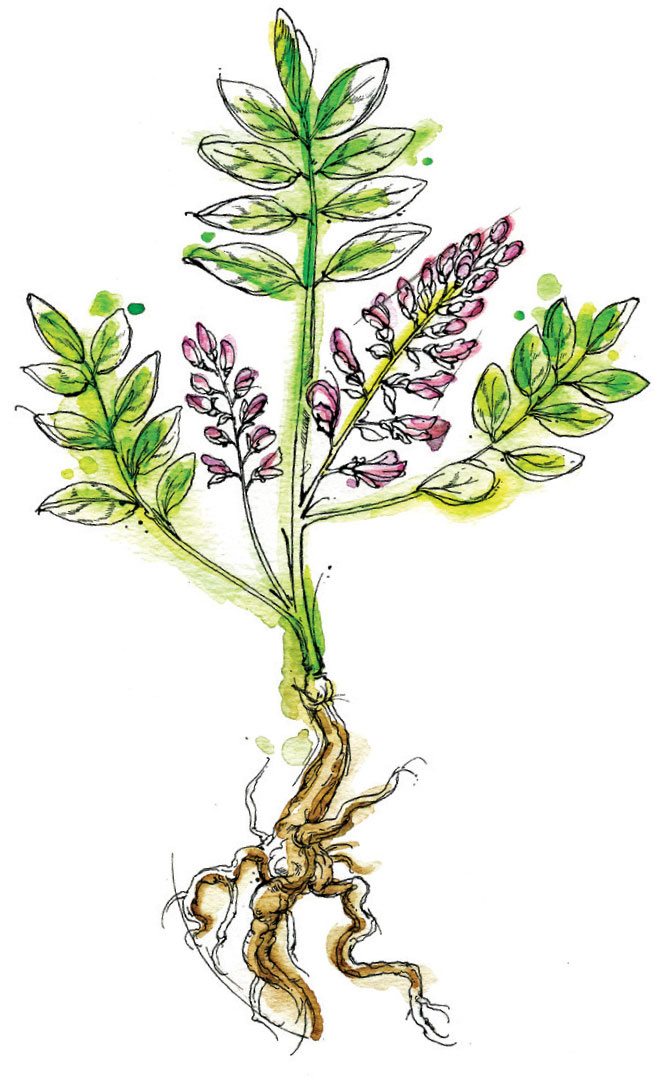
Licorice
Licorice has been used to balance women’s hormones for centuries. Infertility, menopause, irregular cycles, and high cortisol levels due to stress have all been treated with it. Licorice has estrogenic properties that work to normalize internal hormone levels. I particularly like to use it when there is a digestive complaint in addition to the hormone complaint; it has excellent demulcent properties and works to heal the lining of the stomach as well as the digestive track. It was traditionally used to treat ulcers.
A few words of caution: Licorice can be too stimulating for some people suffering from adrenal fatigue. It can feel as though you’ve drunk too much coffee. For others, it’s just the right amount of pick-me-up for the day. Also, licorice has been cautioned against for those with a propensity for high blood pressure and/or water retention. Although it is true that licorice contains compounds that can cause retention of sodium and potassium, fewer than one hundred cases of this effect have been documented worldwide.
MACA ROOT Lepidium meyenii
A. PHASE OF LIFE: Fulfillment
B. PRIMARY USE: Hormone balancing, reproductive tonic, stamina
C. HERBAL ACTION: Adaptogen
If stress has taken its toll and you feel fried, maca might be a good fit. If your hormones feel out of balance as well, definitely give it a try. Although it’s typically a good choice for hormone regulation, it should be used with caution or not at all by women with estrogen-sensitive conditions. The solid research is still out, but maca may cause some who are genetically predisposed to make more estrogens. When you’re entering perimenopause, your hormones are doing their best to find a new normal, and maca truly helps with the transition on that physical level.
MARSHMALLOW ROOT Althea officinalis
A. PHASE OF LIFE: Living, Fulfillment
B. PRIMARY USE: An excellent demulcent promoting anti-inflammatory effects where needed
C. HERBAL ACTION: Demulcent, emollient, diuretic
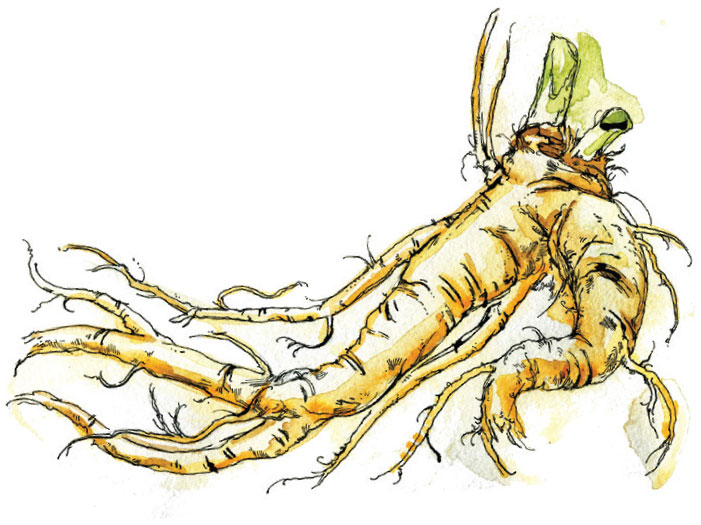
Marshmallow
Marshmallow root is wonderful for any type of irritated tissue, including vaginal. It can be used equally well internally and externally as a wash. It helps with bronchial irritation and with digestive complaints when inflammation is present. Singers can suck on a piece of root for vocal care.
MILK THISTLE Silybum marianum
A. PHASE OF LIFE: Fulfillment
B. PRIMARY USE: A nourishing herb for the liver, with fibroid fighter power as well
C. HERBAL ACTION: Hepatic, tonic, bitter
Milk thistle helps keep the healthy liver cells healthy. Taking it is recommended whenever the liver may be compromised in form or function. It’s often paired with burdock. As I’ve mentioned, liver herbs help to balance hormones and/or bind excess hormones. When hormones are out of balance, new and different things can arise in the body. One of those things may be the manifestation of a benign uterine fibroid. Milk thistle tea has also been used topically for acne vulgaris.
MOTHERWORT Leonurus cardiaca
A. PHASE OF LIFE: Living, Fulfillment
B. PRIMARY USE: A heart protective and harmonizing women’s herb for hormone and emotional balancing
C. HERBAL ACTION: Antispasmodic, astringent, diaphoretic, nervine, emmenagogue, stimulant, sedative
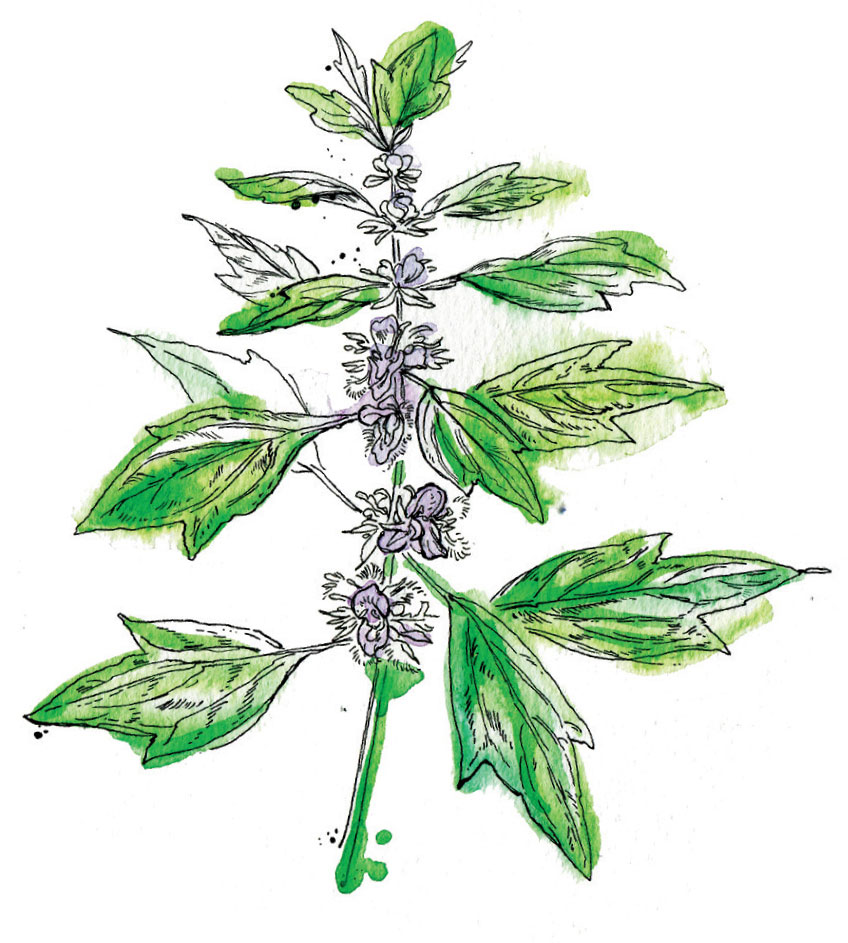
Motherwort
I grow motherwort all around my home, as it is traditionally known to provide energetic protection to your home and family. Combine the folk knowledge with its medicinal properties, and I am a huge advocate of motherwort. First, it balances the connection between the heart and the kidneys. Kidneys contribute to the function of the heart through blood pressure. On an energetic plane, the kidneys root the heart: When the kidneys are functioning, the heart can relax. It does an excellent job of hormone balancing and of calming moments of PMS tension. Motherwort is nature in perfection, with dualistic abilities allowing it to react as needed in given situations. Having both stimulant and sedative properties, it possesses plant intelligence to respond appropriately to what is needed. It is often given when labor is delayed or menstruation is suppressed.
NETTLE LEAF Urtica dioica
A. PHASE OF LIFE: Living
B. PRIMARY USE: Nutritive, allergies, bladder/kidneys, osteoarthritis
C. HERBAL ACTION: Tonic, analgesic, diuretic, astringent
Herbalist David Hoffman says, “When in doubt, give nettles.” And I agree. This incredible herb has amounts of vitamins and minerals that make it helpful in almost any situation. I include it anytime there is a deficiency picture where trace nutrients and weakness are presenting themselves. If you’ve yet to harvest nettles in the wild, I think it is a true rite of passage for any herbal enthusiast. Many don’t know, but fresh nettle leaf steamed or sautéed eliminates the stinging effect and creates the taste of springtime for any meal. Their spring arrival is perfect timing alongside the looming allergy season, almost as a reminder to use them during this time. Nettle’s anti-inflammatory and histamine reducing capabilities make it the perfect ally for allergy sufferers. With all the B vitamins and trace minerals present, it’s no surprise that nettle is great for weakened ligaments and reduced muscle tone. This includes support for both the bladder and the kidneys.
OAT STRAW Avena sativa
A. PHASE OF LIFE: Living, Fulfillment
B. PRIMARY USE: Reducing stress and frayed nerve endings
C. HERBAL ACTION: Nervine, tonic, antispasmodic, demulcent
A simple cup of oat straw, or just the milky tops, combined with chamomile is perfect after a day of stress. When we have stressful events and encounters that seem to come out of nowhere, our emotional well-being can feel blindsided. At times like these, look to oat straw. Safe to use when you’re pregnant, it can be helpful to use as a douche for the yeast infections that sometimes arise during pregnancy. Because of its high nutritional value, it is valuable not only during pregnancy but also later in life, when calcium and magnesium may be deficient. It’s a good herb to use if you are experiencing nervous energy or heart palpitations.
OREGON GRAPE ROOT Mahonia aquifolium
A. PHASE OF LIFE: Fulfillment
B. PRIMARY USE: Helpful for the digestive track and liver by working to remove toxins from the body; vaginitis
C. HERBAL ACTION: Diuretic, laxative, tonic
I recommend Oregon grape root as a place to begin for most skin conditions. After four to five weeks of daily intake of tea or tincture, I will reevaluate. Whenever there is constipation, there is often a skin complaint, and Oregon grape root works on both. Although it is listed as a laxative, I have also successfully used it for treating bacterial diarrhea. High in antimicrobial properties, Oregon grape root has been used to treat vaginitis.
PARTRIDGEBERRY Mitchella repens
A. PHASE OF LIFE: Living
B. PRIMARY USE: Hormonal balancing, partus preparator
C. HERBAL ACTION: Tonic, astringent, diuretic
Partridgeberry is used for various hormonal imbalances that contribute to irregular cycles, infertility, ovary congestion, or painful menstruation/labor. Traditionally given during the later stages of pregnancy to prepare for a smoother birth experience, it can even be given just at birth to reduce complicating pains. Its astringent nature combined with the hormonal support helps with leucorrhea and prolapse complaints.
PASSIONFLOWER LEAF Passiflora incarnata
A. PHASE OF LIFE: Living
B. PRIMARY USE: A pleasant nervine that works to balance and calm the spirit
C. HERBAL ACTION: Nervine, sedative, antispasmodic
Passionflower has long been used to relieve acute stress, such as fear and shock, as well as deficiency that originates out of long-term stress, such as burnout. Try it for insomnia if you tend to overthink every situation. I recommend trying it on its own initially, as it often works well by itself.
PIPSISSEWA Chimaphila umbellata
A. PHASE OF LIFE: Dawning, Living, Fulfillment
B. PRIMARY USE: Bladder tone, membrane protection
C. HERBAL ACTION: Astringent, diaphoretic, diuretic, antiseptic
I often include this herb in urinary system recipes when there is infection, prolapse, and lack of tone. Although it is listed as a diuretic, I find it reduces bladder irritation, which often drives urinary frequency and urgency. The natural antiseptic action helps cleanse the bladder system, and it is best drunk as a tea. It’s supportive with both urinary and kidney stones, aiding in their breakdown and release through the urinary track.
PLANTAIN LEAF Plantago major, Plantago lanceolata
A. PHASE OF LIFE: Living
B. PRIMARY USE: A powerful drawing and astringent herb for skin and tissues
C. HERBAL ACTION: Astringent, demulcent, diuretic, expectorant, hemostatic
Plantain is another herb I use in many cases. Sometimes, when my typical go-tos haven’t produced the expected results, I’ll add plantain. It’s great for the skin and for drawing out toxins from the skin; it also makes a good wash or douche for vaginal discharge. I’ll often include it in postpartum teas to aid in the healing process as well as to give tone to the uterus.
POKE ROOT Phytolacca americana
A. PHASE OF LIFE: Living, Fulfillment
B. PRIMARY USE: A stronger lymphatic herb that works to clear congestion from the lymph glands
C. HERBAL ACTION: Cathartic, immunostimulant, antibacterial
Poke root works well to relieve congestion of the lymph system. We have lymph glands in our neck, armpits, elbows, chest, breasts, and inguinal areas. All these areas are holding zones for what the lymphatic system collects during the day. When infection or viral load increases, the glands collect a lot and can appear swollen and/or tender. This is the right time to utilize poke root. I typically use poke root oil on the areas I need, but taking internal doses works well too.
POPLAR BUDS Populus spp.
A. PHASE OF LIFE: Fulfillment
B. PRIMARY USE: Acute muscle discomfort
C. HERBAL ACTION: Analgesic, anodyne, anti-inflammatory, antibacterial
Fresh poplar buds contain salicin, which our bodies convert into natural pain-fighting power. It’s great for muscle aches and pains; I’ve also had some success with the topical treatment of rheumatic pains. Apply to the temples or nape of the neck for tension headaches or onto a sunburn for relief and skin healing. It also makes a great addition to healing salves for pain relief, because of its antibacterial effects.
PRICKLY ASH BARK Zanthoxylum americanum
A. PHASE OF LIFE: Dawning, Living, Fulfillment
B. PRIMARY USE: PMS, cramping
C. HERBAL ACTION: Anodyne, diaphoretic, irritant, stimulant
It can be virtually impossible to get comfortable when you have severe nerve pain, let alone sleep, work, or exercise. Prickly ash is indicated when the pain is so unbearable you can’t get through the day. Its affinity seems to be on nerves, which arise as sharp shooting pains in the body. One patient had menstrual cramping that would shoot pain down her legs, making it almost impossible to walk. Prickly ash provided enough relief that she could move through her days, allowing her to return to school and work.
PSYLLIUM SEED Plantago ovata
A. PHASE OF LIFE: Living, Fulfillment
B. PRIMARY USE: Treating constipation or diarrhea
C. HERBAL ACTION: Astringent, laxative, demulcent, antitussive, anodyne
Psyllium can be purchased in the seed powder or husk form and used interchangeably. It’s a safe choice for pregnant women who are experiencing constipation or for anyone with digestive issues such as ulcerative colitis or irritable bowel syndrome (IBS).
RED CLOVER Trifolium pratense
A. PHASE OF LIFE: Living, Fulfillment
B. PRIMARY USE: Supporting waste management and reduction of excessive liver by-products
C. HERBAL ACTION: Alterative, expectorant, antispasmodic, tonic, estrogenic
Red clover aids in reducing metabolic waste. It works to stimulate anabolic and catabolic reactions and improve overall function, allowing waste to effectively leave the body and nutrients to be preserved. This is why many herbalists call it a blood purifier. It aids the skin for conditions such as eczema. It is also considered helpful for respiratory conditions. Its estrogenic effects can be helpful for soothing menopausal symptoms. See here for more on phytoestrogen and their functions, use, and safety.
RED RASPBERRY LEAF Rubus idaeus
A. PHASE OF LIFE: Living
B. PRIMARY USE: Nutritive, pregnancy
C. HERBAL ACTION: Tonic, astringent
Red raspberry is often recommended for use during pregnancy for its ability to strengthen and tone the uterus. It prepares the uterus for labor, giving it strength and endurance capabilities. Regular use is said to prevent miscarriage, encourage progression of labor, and reduce cervical tear potential. I also recommend it post labor to encourage the uterus to return to its normal size and tone, and for anyone experiencing prolapse, the slipping down or forward of the bladder or uterus. Red raspberry leaves contain magnesium, potassium, phosphorus, and vitamins A, C, E, and B complex. It also contains easily assimilated calcium and iron. Another tonic herb, it works to support the ligaments and cartilage of the body. The skin loves red raspberry. Adding it to any facial steam or lotion gives the skin a healthy glow and tighter appearance.
RHODIOLA BARK Rhodiola rosea
A. PHASE OF LIFE: Living
B. PRIMARY USE: Any type of chronic stress, cortisol imbalance, or adrenal fatigue
C. HERBAL ACTION: Adaptogen, antidepressant, immunostimulant, aphrodisiac
When a patient presents with adrenal insufficiency or fatigue, I consistently reach for rhodiola. It’s a gentle healer of stress, helping to reestablish normal adrenal function versus overstimulation or hyperreaction. I consider the latter a trauma response that has been experienced over and over, cementing a pattern of physical response. For example: If you have a cantankerous relationship with someone in your life, you begin to physically react in the same way each time you interact with this person. Most likely, you’ll begin to have a sympathetic response. Your heart rate increases, your digestion system shuts down, and your breathing increases. When you experience this repeatedly, the body is basically preparing for fight or flight. Now, let’s say many years go by; the person is no longer in your life, yet you are experiencing the same type of reaction at moments of tiny stressors. You are basically living in the trauma zone, and your body is too. Healing this physically as well as mentally is necessary, and rhodiola can help.
ROSE PETALS Rosa gallica var. officinalis
A. PHASE OF LIFE: When aren’t roses a good idea?
B. PRIMARY USE: To calm any situation, physical or mental
C. HERBAL ACTION: Aperient, astringent, stomachic
What do you think of when you see or smell a rose? Although it may appear delicate, the rose has powerful capabilities to stop bleeding, ease headaches, calm an agitated state, and reduce tension. The rosehips that remain on the bush after the petals fall off make a wonderful addition to flavorful teas, and they are extremely high in vitamin C. A cup of rosehip tea is known to decrease dizziness and ease the stomach. Before I gave birth, I’d heard that rose petals were a strong hemostatic that could be used post labor. The thought of it entranced me, and I tried it. I collected fresh rose petals and wrapped them in cheesecloth. When I was ready, I warmed the wrap in hot water, wrung it out, and applied it like you would a menstrual pad. The soothing was incredible, and my bleeding stopped within the day.
SAGE Salvia officinalis
A. PHASE OF LIFE: Fulfillment
B. PRIMARY USE: Balances hormones, antimicrobial
C. HERBAL ACTION: Antibacterial, antioxidant, aromatic, nervine, emmenagogue, astringent
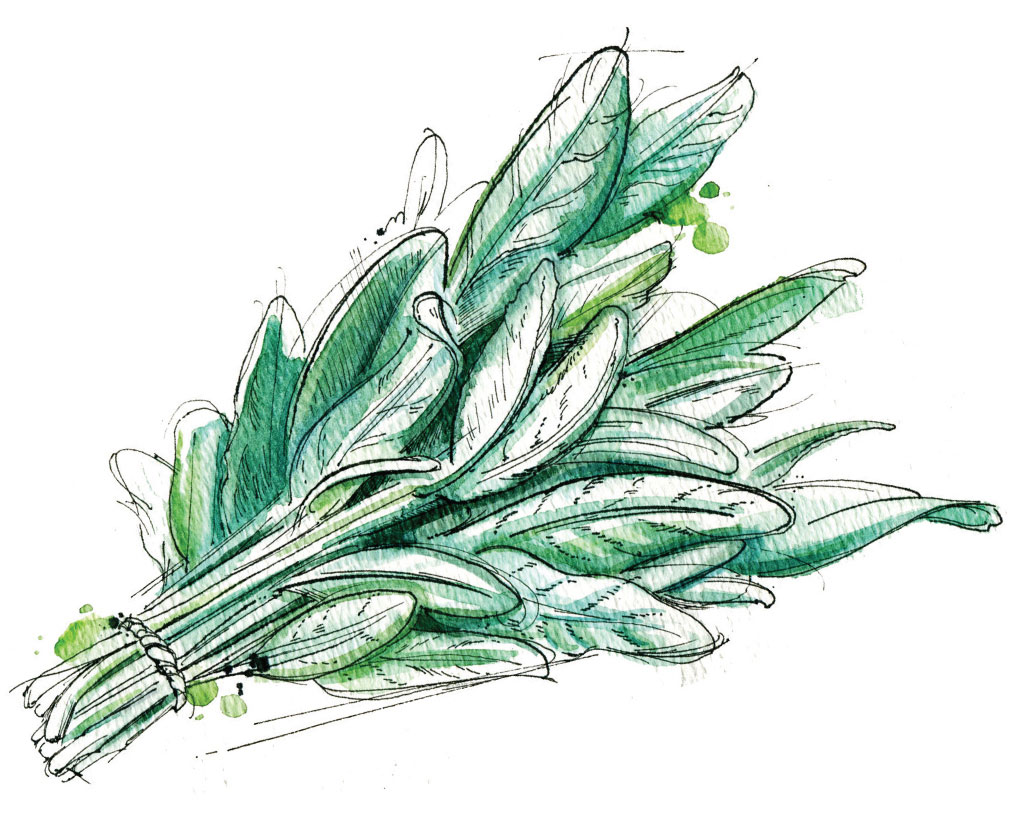
Sage
An abundance of medicine from a common garden plant! Every garden should contain sage. It’s a historical herb that can be seen in drawings and has been recorded in texts for centuries. Traditionally used for colds and flu, drawing upon its antibacterial powers, it also makes a germ-fighting, throat-soothing gargle. It is unfortunate that the use of sage in the kitchen seems to have declined, as it is another opportunity to bring herbal medicine into everyday cooking. We seem to save it only for the big Thanksgiving dinner; yet added to soups and dishes in small quantities, it harmonizes flavors. I was recently at a women’s retreat in Hawaii, and my host was making a beautiful purple potato and vegetable soup. I was so happy when she added fresh sage! It, along with a few other herbs, created a beautifully balanced flavor. Sage is often used heavy-handedly in the kitchen, which tends to turn people off. Try experimenting with this easily grown herb to create a new twist to old dishes. From the medicinal perspective, we also use sage for excessive heat, sweating, and uterine bleeding. It’s a great addition to your body care products, as it helps combat external odor and can darken gray hair.
SASSAFRAS Sassafras albidum
A. PHASE OF LIFE: Dawning
B. PRIMARY USE: Acne formulas
C. HERBAL ACTION: Antiseptic, diaphoretic, stimulant
Known as a good blood purifier, sassafras can be helpful with most skin conditions: acne, eczema, psoriasis, and even gout.
SAW PALMETTO BERRY Serenoa serrulata
A. PHASE OF LIFE: Dawning
B. PRIMARY USE: Affinity for the reproductive system; provides overall tone and support in function
C. HERBAL ACTION: Hormone balancing, antiseptic, diuretic
Saw palmetto has largely been marketed to men for prostate health, but it also has great value to the female reproductive system. It’s proven to reduce ovarian enlargement with chronic irritation felt in the manner of dull and aching pain. When the ovaries are congested or inflamed, saw palmetto overcomes the irritated conditions and acts as a mild sedative to the ovaries themselves. It can affect the breast tissue, particularly when it is slow to develop or exaggeratedly small. It has been reported to improve fertility and overall tone of the bladder. I use it in many of my skin formulas because it has a relationship with the skin via the liver, often aiding in stubborn acne conditions.
SCHIZANDRA Schisandra chinensis
A. PHASE OF LIFE: Living
B. PRIMARY USE: Stress, adrenal support, brain stimulant
C. HERBAL ACTION: Adaptogen, antibacterial
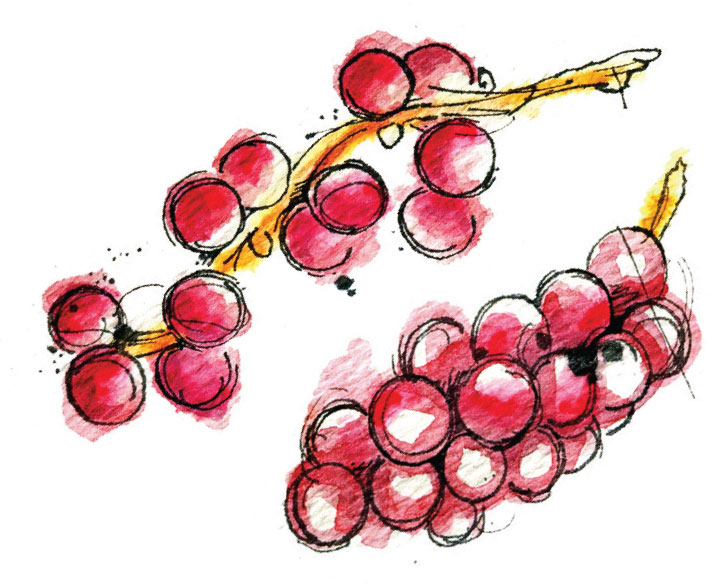
Schizandra
When you read about schizandra, also spelled schisandra, it’s hard not to decide that everyone should be using it. It is known to increase energy, slow the aging process, increase mental function, reduce stress, and prolong life. I use it most often for those experiencing long-term mental and emotional stress that has resulted in adrenal fatigue. If you’ve been dealing with a negative situation in your life for longer than a year, it might be wise to get to know schizandra. Depending on what level of adrenal fatigue you are dealing with, symptoms such as anxiety, stress, anger, insomnia, and/or body pain may arise. Schizandra seems to normalize cortisol release from the adrenal glands, helping it return to normal reaction rates versus constant release. It helps pull us out of survival mode and back into calm day-to-day living. Great for the skin as well, schizandra fights free radical damage and promotes a natural glow.
SENNA LEAF Cassia marilandica
A. PHASE OF LIFE: Fulfillment
B. PRIMARY USE: A stronger bowel stimulant for constipation
C. HERBAL ACTION: Cathartic, diuretic, purgative
Purgatives by nature tend to cause gripping pains in the digestive track; therefore, I recommend combining senna leaf with aloe or fennel.
SHATAVARI Asparagus racemosus
A. PHASE OF LIFE: Living, Fulfillment
B. PRIMARY USE: A wonderful reproductive herbal tonic for women of any age
C. HERBAL ACTION: Tonic, aphrodisiac, galactagogue, antispasmodic, demulcent
An ayurvedic herb, shatavari has made it into the mainstream here in the United States. I recommend it anytime a woman shows general deficiency in her reproductive system. That includes infertility, irregular ovulation/cycles, and low libido at any age. It’s also called “She who has one hundred husbands,” meaning it inspires the desire for enough action that it would take one hundred men to satisfy it. It is also known to balance the pH of the vaginal track to treat leucorrhea and vaginal dryness and is often used for hot flashes.
SHEPHERD’S PURSE Capsella bursa-pastoris
A. PHASE OF LIFE: Living, Fulfillment
B. PRIMARY USE: Stopping heavy menstrual flow by constricting the uterine vessels
C. HERBAL ACTION: Styptic, vasoconstrictor
Shepherd’s purse is a high oxytocin that is a strong uterine contractor. It can be used prior to menstruation to help decrease the flow or during active bleeding when bleeding is excessive. Another use is after childbirth if there is too much blood loss. It can be drunk in small doses, 4 to 6 ounces (120 to 175 ml), several times per day, or 2 dropperfuls ever hour or so until bleeding slows or stops.
SKULLCAP Scutellaria lateriflora
A. PHASE OF LIFE: Living, Fulfillment
B. PRIMARY USE: A nervine that targets anxiety and overly high expectations of oneself
C. HERBAL ACTION: Nervine, antispasmodic, tonic, sedative
I’ve coined the term “monkey mind” for the ideal usage of skullcap. Monkey mind happens right as you lie down at night and begin to think about all the things you should have done that day, all the things you shouldn’t have done, and all the things you have to do tomorrow. It’s your mind pinging from here to there, having difficulty calming down. I also like to use skullcap on those who suffer from internal anxiety. They may look just fine on the outside, but on the inside there is true suffering that needs tending.
SLIPPERY ELM BARK Ulmus rubra
A. PHASE OF LIFE: Living, Fulfillment
B. PRIMARY USE: Digestive support to gently move waste throughout the entire intestinal system, bladder tonic
C. HERBAL ACTION: Demulcent, diuretic, emollient, laxative
Anytime digestion isn’t working properly, there’s possibility for toxic buildup. Chronic digestion complaints not only inhibit nutrient uptake but eventually take a toll on the liver as waste remains in the body longer than it should. Slippery elm bark is a gentle laxative to encourage peristalsis and movement of waste from the body. Anytime bladder irritation is present, drinking slippery elm tea may provide relief due to its emollient action. A wonderful poultice herb, it can also relieve inflammation and pain from most wounds.
SPIRULINA Arthrospira platensis
A. PHASE OF LIFE: Living, Fulfillment
B. PRIMARY USE: Nutritive, restorative, and detoxifying properties
C. HERBAL ACTION: Tonic, immune-stimulant, antioxidant
If you could only eat one thing, it should be ocean plants. Packed with amino acids, protein, vitamins, and trace minerals, they are almost a complete food. Now imagine offering that to your body on a regular basis. I’ve seen hair, skin, and reproductive systems restored when spirulina is included in the treatment regime. It is known to increase metabolism and help the body reduce overall toxic load, which leads to better-looking skin and longevity. It also helps the brain and central nervous system in ways that seem to promote a sense of calm and uplift the depressed spirit.
ST. JOHN’S WORT Hypericum perforatum
A. PHASE OF LIFE: Dawning, Living, Fulfillment
B. PRIMARY USE: Soothing nerve pain, mood stabilizer
C. HERBAL ACTION: Nervine, antispasmodic, astringent
Although much of the modern research and marketing of St. John’s wort has focused on its ability to relieve depression and sadness, its traditional use is for pain. It’s most notable for its ability to ease neuralgia. I’ve used it for menstrual pain, stomachaches, headaches, and even bronchial irritation, St. John’s wort calming each in turn. I have also successfully used it for those suffering from cyclic hormonal depression.
TURMERIC ROOT Curcuma longa
A. PHASE OF LIFE: Fulfillment
B. PRIMARY USE: Reducing inflammation throughout the body
C. HERBAL ACTION: Anti-inflammatory, antibacterial, hepatic, analgesic, cholagogue
It seems not so long ago that Americans caught wind of the benefits of turmeric, but ayurvedic medicine has known about them for centuries. This cooking spice has big effects on aches, pain, and inflammation. Turmeric has shown positive results in clinical studies for acute joint or muscle pain and rheumatoid arthritis. It also naturally supports liver and gallbladder functions, aiding in bile breakdown. It’s good to consider if prostaglandins are high and causing painful PMS symptoms or cramping.
UVA URSI Arctostaphylos uva-ursi
A. PHASE OF LIFE: Dawning
B. PRIMARY USE: A herb with an affinity for the bladder and kidney systems, focusing on removing stones and infection
C. HERBAL ACTION: Antilithic, astringent, diuretic
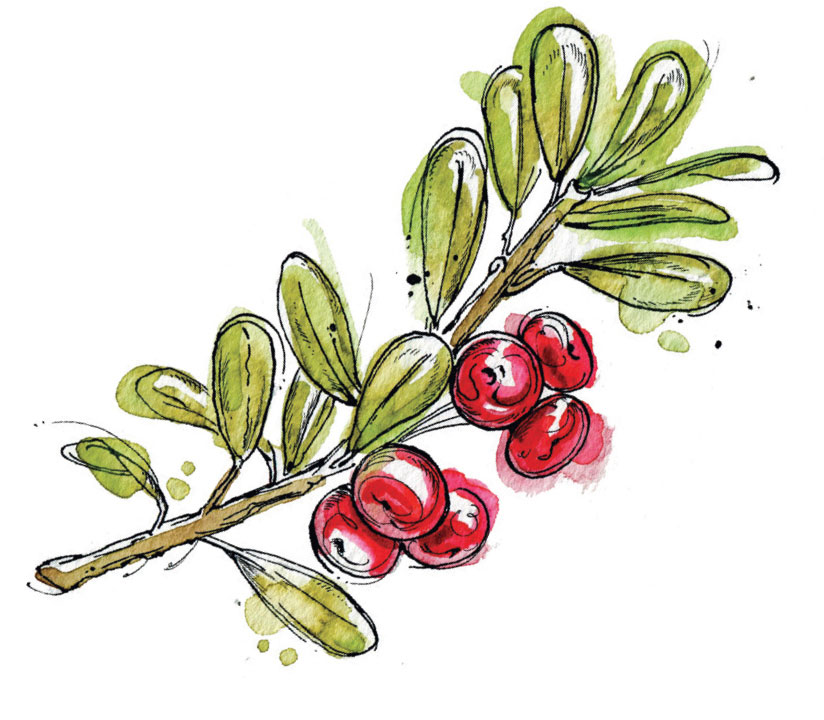
Uva Ursi
Also referred to as bearberry, this herb has a stronger effect on the bladder and kidneys than pipsissewa (see here) and should not be used long term. Effective with most cases of cystitis and stones, it helps rid the body of stones while aiding in pain relief. Topical application is also used to relieve vaginal irritation and pain.
VITEX (CHASTE TREE) BERRY Vitex agnus-castus
A. PHASE OF LIFE: Dawning, Living
B. PRIMARY USE: The herb for estrogen/progesterone balancing
C. HERBAL ACTION: Tonic, emmenagogue, adaptogen
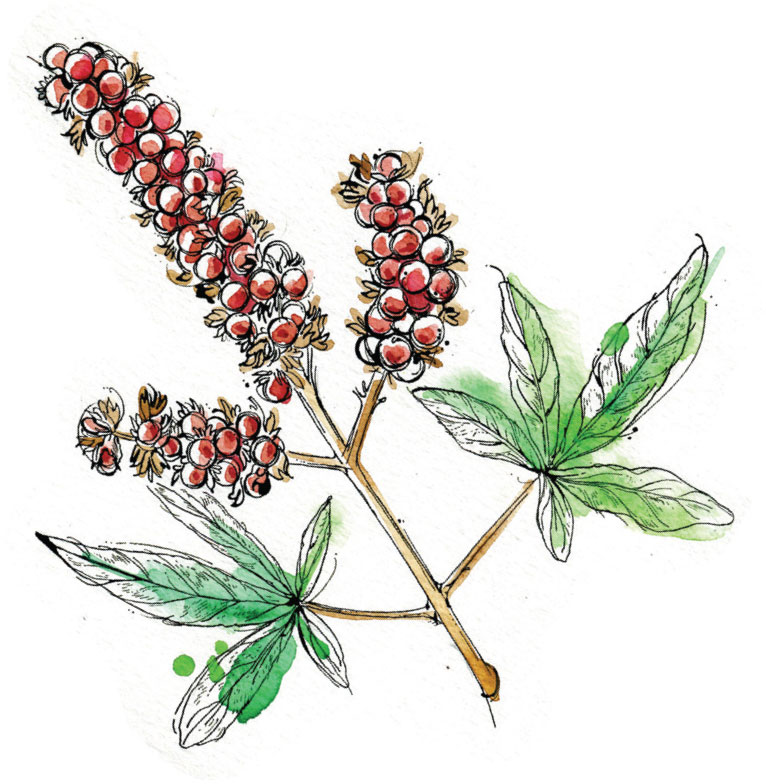
Chaste Berry
When you hear a good quote, it’s hard to forget it. Regarding vitex, herbalist David Hoffman once said, “Vitex will always enable what is appropriate to occur.” I have found that to be true. Used for normalizing cycles, it also aids in the transition after a woman stops birth control. Endometriosis patients have had some success with pain reduction using vitex, and new mothers have used it to increase breast milk supply. Known to increase progesterone, it can harmonize hormones and circulate the energy of the reproductive system. In traditional Chinese medicine, it is known to possess both warming and cooling natures.
WHITE PEONY Paeonia albiflora
A. PHASE OF LIFE: Living
B. PRIMARY USE: Used when infertility is a concern due to PCOS, endometriosis, ovarian issues, or hormone imbalance
C. HERBAL ACTION: Emmenagogue, anti-inflammatory, antispasmodic
White peony is traditionally use in Chinese herbal medicine, but it has made its way into the Western herbal culture over the past few decades. It’s a useful consideration when working with ovarian failure or PCOS, as it appears to stimulate the ovarian follicles. Other studies have shown that it positively affects low progesterone levels and regulates estrogen in the body. When used in combination with other emmenagogues, white peony has shown value in bringing on menstrual cycles.
WILD YAM Dioscorea villosa
A. PHASE OF LIFE: Living, Fulfillment
B. PRIMARY USE: The original birth control, wild yam’s constituents were the first ingredients used to make contraceptive medications.
C. HERBAL ACTION: Antispasmodic, cholagogue, hepatic, anti-inflammatory, diaphoretic, uterine tonic
Wild yam does not contain progesterone, but it does have a precursor that can act as a stimulator to produce natural progesterone. Hence the abundance of wild yam creams on the market. As with any herb, it is important to understand how it truly works in the body so that you can make wise decisions regarding your health care. Wild yam has traditionally been used as a tonic for the uterus and hormones, often leading to a decrease in PMS and uterine cramping. If excess estrogen is a problem, wild yam may be a good herb to try. It’s a good one to add to formulas when trying to reduce fibroids. Continuous use for 6 to 12 weeks before steady changes are observed is typical.
YELLOW DOCK Rumex crispus
A. PHASE OF LIFE: Dawning, Living, Fulfillment
B. PRIMARY USE: A liver tonic and herb that helps the body assimilate minerals such as iron more efficiently
C. HERBAL ACTION: Antioxidant, hepatic, bitter, astringent
Although not having a high iron content itself, yellow dock can help women assimilate iron in a better way. Iron is typically absorbed in the duodenum, so ensuring digestion is functioning properly and that digestive inflammation is low or absent are key to better iron absorption, as is decreasing excessive bleeding. Therefore, combining carminatives, digestives, and herbs such as shepherd’s purse, to decrease menstrual bleeding, should all help increase iron. I often use yellow dock with other hormone-balancing herbs when fibroids or ovarian cysts are present. Yellow dock’s affinity for the liver makes it a great addition to skin formulas as well.
YUCCA Yucca spp.
A. PHASE OF LIFE: Fulfillment
B. PRIMARY USE: Decreasing inflammation in the body
C. HERBAL ACTION: Analgesic, anti-inflammatory, antirheumatic
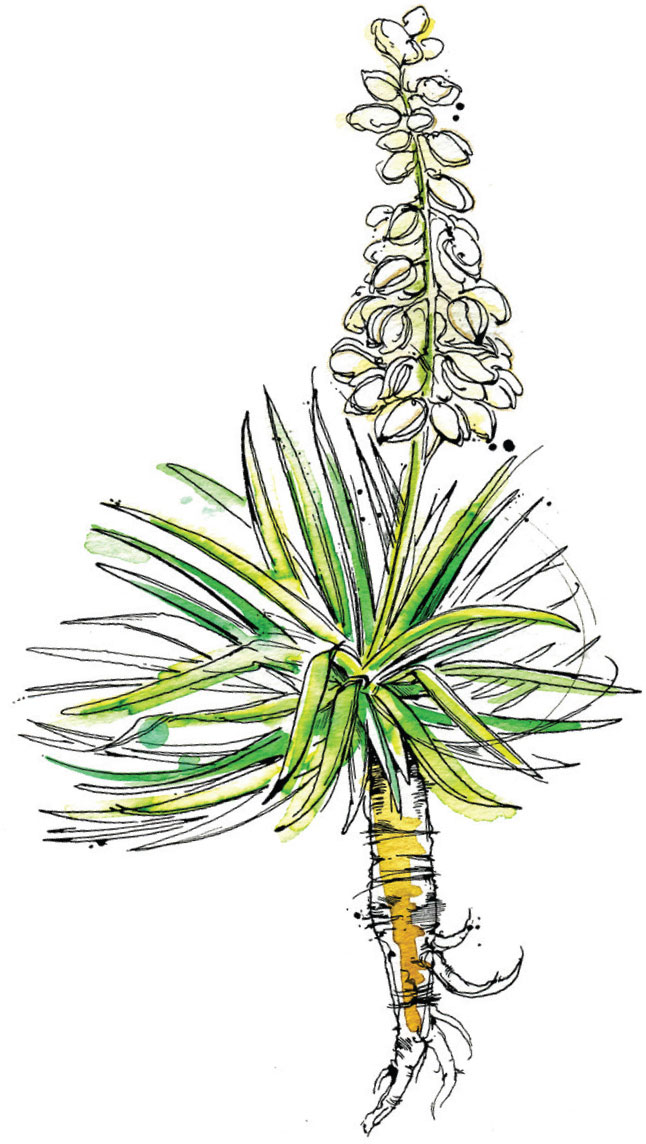
Yucca
There was a yucca plant growing in the backyard of a house I once rented. Knowing its potent anti-inflammatory powers, I was excited about it. Unfortunately, it was growing in the worst place—right along the edge of my backyard sitting space—and after the fiftieth time I got poked and scratched, our relationship began to deteriorate. I resolved that if I couldn’t live with it, I’d make the best medicine I could from it. What a torturous endeavor taking out a yucca plant turned out to be! After several days of trying, I still couldn’t get all the root base out of the ground. Just like the liver regenerates itself, this thing grew completely back within the year. I made medicine with what I had collected and vowed to honor the plant moving forward. But on my journey, I got to see the freshly cut root and how it wove itself together, just like the body’s cartilage and ligaments. Another herb had “shown” me its function in reducing inflammation and stimulating the healing of the fine and delicate structure supporters of the human body.
CONDITION |
HERBS TO TRY |
LIFE PHASE: DAWNING |
|
Regulating cycles |
Vitex Berry, Dong Quai, Motherwort, Partridgeberry, Lady’s Mantle, Angelica Root, Chamomile Flowers |
Painful Menstruation |
Crampbark, Silk Tassel, Black Cohosh, Hops, White Oak Bark, California Poppy, Wild Yam, Valerian Root |
Spotting Between Periods |
Red Raspberry, Vitex, Shatavari, Shepherd’s Purse, Chamomile, Lady’s Mantle |
Breast Tenderness |
Turmeric Root, Poke Root, Cleavers, Dandelion Leaf, Lemon Balm, Boswellia |
Bloating |
Calamus Root, Dandelion Leaf/Root, Fennel Seed, Peppermint, Caraway, Anise Seed, Ginger Root, Chamomile Flowers |
Hormone Tonics |
Blue Vervain, Burdock, Bupleurum Root, Vitex Berry, Tribulus, Barberry, Maca |
Headaches |
White Willow Bark, Lavender Flowers, Peppermint, Hops, Blessed Thistle Leaf, Black Cohosh, Turmeric Root, Valerian |
Mood Swings |
Passionflower, Ginkgo Leaf, St. John’s Wort, Chamomile Flowers, Wood Betony, Skullcap, Schizandra Berry |
Yeast Infections |
Goldenseal Root, Myrrh, Slippery Elm Bark, Usnea Lichen, Pau D’Arco, Yarrow Flower, Lavender Flower, Calendula, Chickweed, Plantain, Comfrey Leaf, Rose Petals |
LIFE PHASE: LIVING |
|
Fibroids |
Burdock Root, Dandelion Root, Yellow Dock Root, Oregon Grape Root, Wild Yam Root, Black Cohosh |
Ovarian Cysts |
Vitex Berry, Blue Cohosh Root, White Peony Root, Chickweed, Crampbark, Poke Root, Nettle Leaf |
PCOS |
Prickly Ash Bark, Milk Thistle, Dong Quai, Motherwort, Dandelion Root, St. John’s Wort, Poplar Buds, Turmeric Root, Saw Palmetto |
Endometriosis |
Shepherd’s Purse, Cinnamon Bark, Blue Cohosh, Cayenne, Mistletoe, Ginger Root |
Heavy Bleeding (Menorrhagia) |
Shepherd’s Purse, Cinnamon Bark, Blue Cohosh, Cayenne, Mistletoe, Ginger Root |
Fertility |
Maca Root, Spirulina, Kelp, Burdock, Wild Yam, Sassafras, Angelica Root, Sassafras Bark, Black Cohosh, Maca, Dong Quai, Skullcap, Passionflower |
Pregnancy |
Red Raspberry Leaf, Rose Petals, Partridgeberry, Ginger Root, Lemongrass, Catnip, Nettle Leaf, Lemon Balm, Ashwagnadha Root, Calendula Flowers, Jasmine Flowers |
Postpartum |
Comfrey Leaf, Calendula Flower, Basil Leaf, Holy Basil Leaf, Rose Petals, Rosemary Leaf, Lavender, St. John’s Wort, Astragalus Root, Schizandra Berry, Nettle Leaf, Goat’s-Rue, Fennel Seed, Shatavari, Hops, Fenugreek Seed, Red Raspberry Leaf, Blessed Thistle, Oat Straw, Skullcap |
LIFE PHASE: FULFILLMENT |
|
Vagina Health |
Calendula Flower, Chamomile Flower, Comfrey Leaf, Elderflower |
Libido |
Shatavari Root, Maca Root, Tribulus, Licorice, Passionflower, Damiana Leaf, Ashwagandha Root, Vanilla Bean, Ginger Root, Cardamom, Rose Petals, California Poppy, Kava Root |
Hormone Regulation |
Sage, Black Cohosh, Shatavari, Peppermint, Wild Yam, Maca, Black Cohosh, Nettle Leaf, Dong Quai, Yellow Dock Root, Partridgeberry, Vitex Berry, Spirulina, Eleuthero Root, Lemon Balm, Rhodiola Root Bark |
Bone Health |
Nettle Leaf, Alfalfa Leaf, Comfrey Leaf, Horsetail Leaf, Hawthorn Berry, St. John’s Wort, Black Cohosh Root, Yellow Dock Root, Chickweed Leaf, Rosehip Powder, Green Tea Leaves, Dandelion Leaf, Rosehips |
Hot Flashes |
Black Cohosh, Sage Leaf, Peppermint Leaf, Maca Root, Gingko Leaf, Shatavari Root, Hibiscus, Linden Leaf and Flower, Borage Leaf, Rosemary, Lavender, Yarrow Flowers, Peppermint, Bupleurum Root, Borage Leaf, Chickweed, Cleavers, Burdock Root |
Sleep and Stress |
Lemon Balm, Chamomile Flower, Wood Betony, St. John’s Wort, Angelica Root, Eleuthero Root, Spirulina, Wild Yam, Skullcap, Hawthorn Leaf and Flower, Sage Leaf, Turmeric Root, Sage Leaf, Chickweed, Skullcap |
Brain Support |
Gotu Kola Leaf, Skullcap Leaf, Linden Leaf, Rosemary Leaf, Sage Leaf, Rooibos, Turmeric Root, Cayenne, Dandelion Root, Nettle Leaf, Licorice Root, Ginkgo Leaf, Hawthorn Leaf and Flower, Lobelia |
Thinning Hair |
Spirulina, Schizandra Berry, Horsetail, Nettle Leaf, Kelp, Reishi Mushroom, Green Tea, Ginkgo Leaf, Rosemary Leaf |
LIFE PHASE: SUPPORT |
|
Liver Balancing |
Dandelion Root, Milk Thistle, Chicory Root, Burdock Root, Red Clover Blossoms, White Oak Bark, Milk Thistle Seeds, Dong Quai Root, Nettle Leaf, Artichoke Leaf, Yellow Dock Root, Saw Palmetto Berry, Wild Yam Root, Bupleurum, Black Cohosh Root |
Digestive Support |
Gentian Root, Skullcap Leaf, Ginger Root, Chamomile Flower, Fennel Seed, Anise Seed, Fenugreek Seed, Catnip Leaf, Marshmallow Root, Licorice Root, Cranesbill Root, Goldenseal Root, Plantain Leaf, Oregon Grape Root, Agrimony Leaf, Lemongrass, Senna Leaf, Slippery Elm Bark, Angelica Root |
Breast Health |
Poke Root, Chamomile Flowers, Dandelion Root, Calendula Flowers, Rose Petals, Comfrey Leaf, Elderberry Flowers |
Stress Support |
Rhodiola Bark, Schizandra Berry, Ashwagandha Root, Burdock Root, Eleuthero Root, Licorice Root, Passionflower Leaf, Skullcap Leaf, Chamomile Flowers, Catnip Leaf, Lavender Flower, Rose Petals, Celery Seed, Kava Root, California Poppy Flowers, Hops, Agrimony Leaf, Oat Straw and/or Milky Oat Tops, Lemon Balm Leaf, Hawthorn Berry |
Bladder Health |
Buchu, Nettle Leaf and Root, Red Raspberry Leaf, Fenugreek, Burdock Seed, Lady’s Mantle, Goldenrod, Catnips Leaf, Pipsissewa Leaf, Corn Silk, Dandelion Leaf, Cleavers, Marshmallow Root, Chickweed, Chamomile Flowers, Uva Ursi Leaf, Goldenseal Root, Oregon Grape Root |
Thyroid Support |
Kelp, Parsley Leaf, Barberry, Cleavers, Motherwort, Goldenseal Root, Bugleweed Herbs, Black Walnut Hull, Lemon Balm Leaf, Mullein Leaf, Lobelia Leaf, Spirulina, Eleuthero Root, Alfalfa Leaf, Nettle Leaf, Licorice Root |
Cardiac Health |
Motherwort Leaf, Hawthorn Berry, Hawthorn Leaf And Flower, Ginger, Hibiscus, Rosehips, Safflower, Gingko Leaf, Maca, Skullcap Leaf, Chamomile Flower, Catnip Leaf, Wild Cherry Bark |
